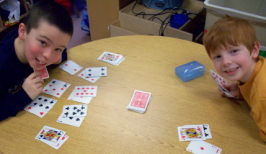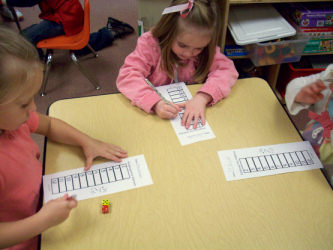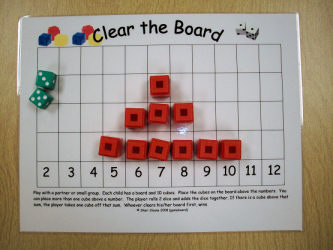Math Centers and Games(Click on any image to see a larger version of that image.)
10s Go Fish - This game is played just like "Go Fish." Instead of asking for a card to match your card, you have to ask for a card that would add with one of your cards to make a sum of 10. I introduced the game with out class 4th Grade buddies, but it was still really difficult. So I made up this little cheat sheet to show that combos that make 10. I laminated them to use again and again. The kids loved it so much they all wanted a cheat sheet to play it at home. Very quickly, the kids stopped using the cheat sheet.

Shape Fill In - This is the perfect game to differentiate your instruction. Two kids share one sheet. They should have a different colored crayon. The first child rolls and colors in that many squares. To make it more difficult, they can add 1 to what they rolled and color in that many. The next child follows repeating the steps with a different colored crayon. They keep rolling until they have colored in the entire sheet. Then each child counts how many squares they have colored in. The one with the most squares colored in, wins (or spin the more/less spinner to see if more or less wins.)

Click here for the Shape Fill-in Heart.
Shake and Share - To play this game, you need to make Casino bottles. They are just the small water bottles filled with water, some glitter and 2 dice. I seal the bottles shut with E6000 glue. All the kids do is shake the bottle and look at the numbers at the bottom of the bottle. There are 2 blacklines the kids can use. They add the 2 dice with the adding sheet or they subtract the smaller number from the larger number on the subtracting sheet.

Click here for the Shake and Share Subtraction PDF.
One More - To play this game each, 2 children will share a sheet and a die. Each child should have a different colored crayon. The first player rolls and crosses off the number or dots that are "One More" than the number rolled. The next player does the same. The game continues until someone gets 4 in a row.

More or Less? - When I first played this game I used unifix cubes and a bowl to draw from. I ordered Centimeter cubes and drawstring bags to use in the future. Either one is fine. To play the game the child grabs a handful of cubes (2 different colors.) He/she counts how many of each color cube they grabbed and writes the numerals down. The child circles whatever number is bigger. In 2008, Jenna took it a step farther. She wrote the number words instead of the numerals. Those kids are always thinking:)

Count and Color - This is a very simple center. Each child has his/ her own sheet. The child rolls 2 dice and colors in the square. Continue until all squares are filled in.

Dice in Dice - I can not tell you how popular this center was with my kids. I had to give them all a "Dice in Dice" from Learning Resources and the blacklines at home, per their begging. Jack D. had the entire front and back filled (in very small printi) by the very next day. For this center you need the "Dice in Dice" from Learning Resources. I got mine at www.lakeshorelearning.com. All the kids do is roll one "dice" and add and record the number sentence. They can also subtract the smaller number from the larger number as well.

Click here for the Dice Subtract PDF.
Make a Train Race - You will need unifix cubes, a precut piece of yarn (about a yard) and a die. The children play with a partner. The first child rolls a die and makes a train with that many cubes. They lay the cubes on one side of the yarn (at the end of the yarn.) The next child repeats and lays the cubes on the other side of the yarn. The child repeats, adding the cubes to his/her side of the yarn. The winner is the first child to get to the end of the yarn.

Bump - The children play "Bump" with a partner. Each child takes 10 unifix cubes of one color. His/her partner should have a different color. The first child rolls 2 dice and puts a cube on that number. If another player’s marker is on that number BUMP it off. If your marker is on that number, link the cubes together and it freezes that spot. The winner is the player that uses all of his/her markers first!

Click here for Valentine’s Day Bump! Click Here for Christmas version of Bump! Click Here For Thanksgiving Version of Bump!
Kindergarten Yahtzee - This game is so funny to see how excited the kids get. All they have to do is roll 2 dice and cross out the sum. They keep going until they have crossed out all of the numbers. They learn the hard way how hard it is to roll a 2 or a 12!

Clear The Board - This is a great game for teaching probability. I laminate a set of the game boards for use in the classroom. Each child has a board and 10 unifix cubes. Each child places the 10 cubes above the numbers they predict they are going to roll. Then each child takes turns rolling 2 dice. If they roll a number that has a cube above it, the child removes one cube above that number. If the player does not have a cube above the number he/she rolled, his/her turn is over. Then the other child goes. Play continues until one player "Clears the Board."

Treehouse Game - This game is to practice Odd and Even Numbers. The directions state to use a deck of cards, but my kids just used dice whenever they wanted to play the game quickly (which they wanted to play it a lot.) With a partner, each child decides if they are going to be odd or even. They draw a card (or roll dice) and if the number is what they chose (odd or even) they write the number on the bottom rung of the ladder. If it is not what they chose (odd or eve) his/ her turn is over. The first child to the top of the treehouse is the winner.."

Crossout and Addition Crossout - There are 2 different versions of this game. The first one is played with 1 die. The addition version is played with 2 dice. The kids play with a partner. The kids take turns rolling the die or dice and cross out whatever they roll. If he/she can not cross out that number (all have been crossed out) that player's turn is over. Play continues until someone crosses off the last number. He/she is the winner.

Click Here For Crossout Addition PDF.
What Did You Roll? - This is just a simple center to practice dot configuration recognition. The kids roll a die and color in what they rolled. They continue until the sheet is filled. Click Here for What Did You Roll PDF.
Make Zero - To do this center, each child takes a cup or bag full of cubes. He/she counts the number of cubes and writes that number in the first blank. They then roll a die and write that number in the second blank. Subtract that many cubes. He/she writes the answer. Continue the next line with the answer. Play continues while subtracting until you have zero cubes. Repeat with new cubes.

Roll the Die - This is another simple die game for dot configuration recognition. The students can use dot dice or numeral dice. The kids roll and color in the section that matches what they rolled. Play continues until the sheet is filled. Click Here for Roll the Die PDF.
Ordering Numbers - To play this game, the kids need 4 - 10-sided dice. You can also make dice using wooded cubes. Have 1 have all odd numbers, 1 have even numbers and the remaining 2 have random numbers from 1 -14. To play the child rolls all 4 dice and put them in numerical order. The child the writes the numerals in order. Repeat.

What Comes Before? or What Comes Next? - This is a great game for practicing number order. To play "What Comes Before?" the child rolls 2 dice and writes the number on the last line. The child then write the 3 numbers that come before the number. For "What Come Next?" the child rolls 1 or 2 dice and writes that number and then the 3 numbers that come after it. Click Here for What Comes Before? PDF. Click Here for What Comes Next? PDF.
Coin Exchange Game - This is a money game. The kids roll a die and put that many pennies on the board. When they can trade up to the next coin, they do. The game is over when they get a quarter.

Race To Trace - This is such a simple game, but the kids love it. They actually cheered when they got to do it again today and quite a few of the kids continued playing into Free Choice Time. The kids roll a die and trace that numeral. They repeat until all of the numbers are traced. To make it last longer, I have the kids continue writing numerals on the back when they have completed the front side.

Race to Ten - This game needs the add or subtract spinner. The kids roll a die and spin the spinner. They add or subtract that many cubes to their board. They try to get exactly 10 cubes on the board. If they go over 10 they take a second board. (I tell them no more than 2 boards.)

Unlucky Seven - This game has the directions right on it. It is a really good way for kids to understand probability. The kids roll 2 dice and add them up. They cross out what they got. They have to cross out the entire top roll before they cross off all of the 7s. Click Here for the Unlucky Seven PDF.
Rainbow Math - This game is very simple. The kids roll 2 die and color in the sum on the rainbow. The game is over when the rainbow is colored in.

Fill the Hexagon - This game is great for learning the shape names (we now have to earn hexagon and trapezoid) and visual discrimination. You need to make special dice using 1 hexagon, 2 diamonds,1 trapezoid and 2 triangles. Each pair of kids need 2 dice. I made mine with a die cut die shape. The directions are on the board. Each child rolls 2 dice and has 2 put those 2 shapes on the board. They can not be moved after they are placed. The first one to fill the board is the winner.

Fill the Hexagon Paper Version - The kids can glue down the paper shapes of the pattern block shapes instead of using real pattern blocks.

Under the Bowl - This is an old "Math Their Way" game that helps kids internalize the combinations that make a sum. Kids are with a partner and they have a certain number of cubes. One partner closes his/her eyes and cubes are hidden under the bowl. The child opens his/her eyes and tries to figure out how many cubes are under the bowl. Both kids say the number sentence and they both write it on the recording sheet.

Race to 20 or Race to 50 - The kids play these games using seasonal candies or any other object. We do "Race to 20" early in the year and then move to "Race to 50" after January. The kids roll 1 die, count out that many candies in a pile and then add them to the board saying the numbers as they place them in the square. The candy corn and hearts clipart are from www.djinkers.com I LOVE their clipart program. I think I own at least 10 CD collections.

Click Here for the Race to 50 PDF.
Race to Trace Addition - The kids loved the regular Race to Trace so much I made one where the kids have to use 2 dice and add them up. If you want to kids to work on "counting on" use 1 numeral die and 1 dot die. Have them say the numeral first and then add on the dots.

|
